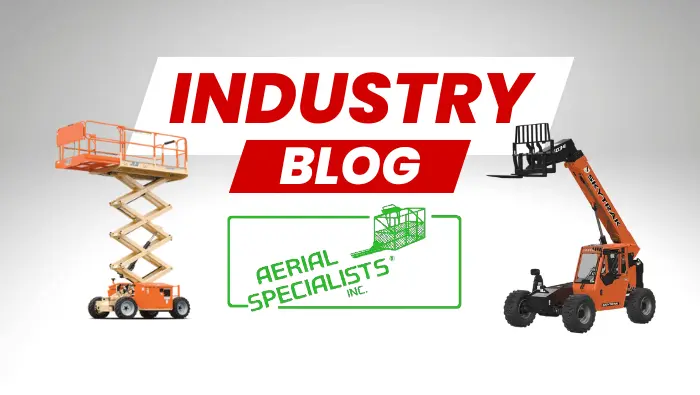Aerial Specialists Asks: Can Replacement AWP (mewp) Parts ….. Create a Liability Issue?
Many aftermarket parts houses claim to provide the same quality (or even better quality) parts, made to OEM specifications, all at a considerable savings – as much as 80% of the manufacturer’s suggested retail price.
- This claim certainly grabs your attention.
- The prices are enticing.
- But what’s at RISK?
A GENUINE OEM part usually carries a FULL Warranty, whether purchased directly from the manufacture or from an aftermarket parts house that specializes in OEM parts, as long as it’s an OE Original. The Warranty helps trim your Liability exposure to a minimum. The Warranty not only insures performance, but it documents the name of the company that supplied it. That knowledge can be important if you’re summoned to court due to an incident or accident caused by a replacement part failure. It’s heartening to know that most OEM manufacturers will stand beside you during this litigation.
On the other hand, OEM parts may not always be available. It’s no secret that the challenge of buying reliable replacement parts is compounded by the recent trend of manufacturer acquisitions and/or closures, especially in today’s world where 95% of the US based AWP manufacturing community is now defunct. Acquired lines of manufacture are, quite often, abandoned, leaving owners scrambling for components to repair older but profitable equipment. The purchase of “used structural parts” many be the only choice on these occasions, however given the fact that one would be putting someone “in the air on used-structural-parts”, I would tend to frown on that idea!
Fabricated parts should “meet or exceed” the specifications of the Original equipment manufacturer. If the equipment in question is in fact obsolete, it may be difficult to acquire those specification’s. Often a reputable fabricator can determine material composition by analyzing the broken part and building a NEW REPLACEMENT to those specification’s. (Be sure to get test results from the manufacturing fabricator or form an independent engineering firm that shows that the replacement part “meets or exceeds” the Original OEM manufacturer’s specifications). They should provide you with the “Rockwell Hardness” test results of the replacement part compared to the original (all be it) damaged part. It is important to know the “yield and tensile strength” of the replacement component and the type of alloy steel used in making the replacement. Even more information can be useful – depending on the replacement part required. In fact, you may need an engineering degree to fully grasp whether or not the fabricator is capable of producing the desired proper replacement. For example, when engineering a scissor-arm pivot pin, knowledge of the specific scissor-arm geometry is critical to ensure a proper replacement of pin bosses and/or location of pin centers. Does the fabricator have (or have access to) the Original “Jig Fixtures” needed to determine correct pin placements? When purchasing parts from a fabricator, it’s not only worthwhile to determine the Quality of the part, but also the Quality of the Company providing it. Are the replacement parts of US origin OR are they simply knockoffs or Chinese imports? Will the supplier be around when you face the judge or litigators in a liability suit?
Sometimes, even when new replacement parts are available, it may be less costly to have the Original part rebuilt! Again, you’ll want to know just “who” your dealing with. Most manufacturers refuse to recommend a rebuilding facility. This is true even if the manufacturer doesn’t rebuild the part themselves. By recommending a rebuilder, the manufacturer increases their own liability exposure, yet has no control over the finished product. Also, manufacturers are careful about giving out specifications or component curve charts and graphs detailing the engineering of their component’s. Without this information a rebuilder can’t guarantee that their rebuilt part “meets or exceeds” the Original OEM specifications. Reputable rebuilders who have been in business a long time usually have the Original OEM specifications and also may own some of the Original OEM Test stands. When looking for a rebuilder, it often makes good sense to determine how long they’ve been in business. However, don’t use that as your only criterion, If possible, take a tour of their facilities. Look at their stocking inventories’ to validate that the rebuilder is utilizing and using OEM components. Ask for parts invoices. A reputable rebuilder should have no problem showing you what they pay for parts and where they bought them. You should expect a detailed service report that outlining incoming and outgoing test results. While many good rebuilders exist, stories about “rip offs” and shoddy workmanship are common place in the aerial platform industry and many “rip-off” rebuilders who do poor work have learned to hide it.
In these days of strict liability and reckless supplier litigation, an aerial lift fleet owner can’t be to cautious. Choosing a parts supplier has never been more critical.
_____________________________________________________________________________________________________________ Written by: Craig Ihde – AWP industry veteran with over 40 years of real-world experience training, servicing, manufacturing and working with and around aerial lift equipment. Craig brings unmatched insight into the realities of certification and safety in the lift equipment world and is the owner of Aerial Specialists, Inc. USA

